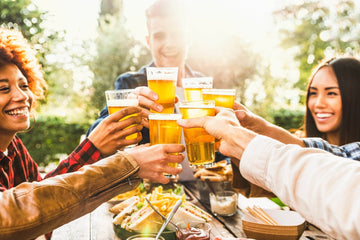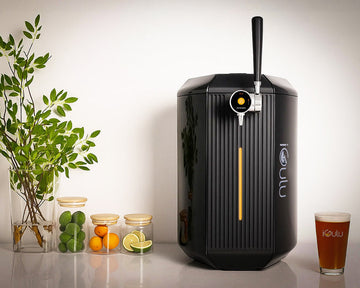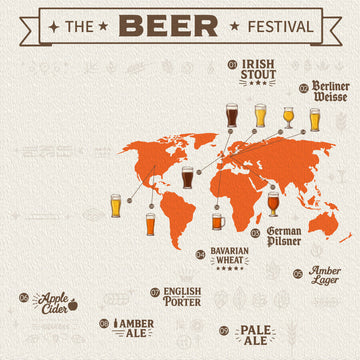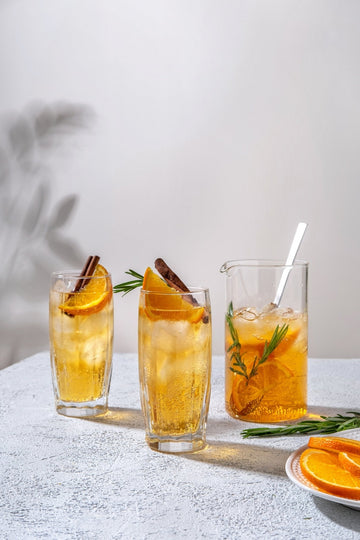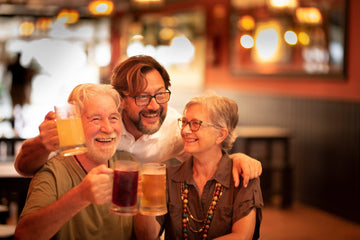Not every beer can refresh and quench your thirst on a scorching hot day. During the warmest season, beer drinkers tend to lean towards lighter, crispier beer styles.
Some may enjoy the bready and citrusy notes of wheat beers, while others may prefer a light hop bitterness from Pilsner-style brews. Whichever beer they might gravitate towards, there are a few common denominators: they’re refreshing, drinkable, and low in alcohol.
In this article, we’ll cover what makes a great summer beer, how to make one at home using your trusty iGulu, and how you can customize the recipes with the Master Mode.
Let’s dive straight in.
What Makes a Great Summer Beer?
A summer beer isn’t defined by style, ingredients, origin, or any similar category. What makes a brew a “summer beer” is its ability to keep you cool and refreshed without weighing you down.
This can be achieved in several ways. First, we have lower alcohol content. Most summer beers have an ABV of 3.5-5%, allowing you to drink a few bottles without getting tipsy in the heat.
The bitterness sits somewhere in the middle, ranging between 15 and 35 IBU. This means summer beers have a slight kick of sharpness, but it’s not overwhelming the other flavors.
Regarding the body, summer beers have a light to medium body with an SRM of 2-10. There are two reasons for this. First, beers with a lighter body are more hydrating, which is particularly important when you’re already losing your body moisture through sweat on a hot summer day.
And second, thicker, full-bodied beers are served warmer to allow you to taste their flavor profile. On the other hand, summer beers are flavorful even when served cold, which is what you want when trying to cool down with a drink.
It’s worth noting that flavor profile also influences how refreshing a beer seems. Certain flavors and sensations can either cool the flavor palate or weigh it down.
Many summer beers lean on bright, clear esters or subtle fruit notes, as citrus or stone fruit, to enhance perceived freshness. Heavy or overripe fruits, on the other hand, would start to feel cloying over time.
If this seems a lot like an explanation of a session beer, you’re onto something. Session and summer beers overlap in many things for a simple reason–all summer beers are sessionable.
However, not all session beers are summer beers–some are more suitable for different seasons. Just think of a low ABV porter, which is more suitable for colder months of the year.

Top 5 Summer Beer Styles and Recommended iGulu Kits
Whether you’re making barbecue in your backyard or heading to the beach, summer beer should be your brew of choice. Here’s a breakdown of the top five summer beer styles that hit just right in warm weather, along with specific iGulu F1 settings to help you recreate them at home.
If you’re still unsure how to use your F1, here’s a deep dive video on brewing beer with your machine:
Helles Lager
Overview:
-
Bitterness: 18-22 IBU
-
ABV: 4.7–5.4%
Helles is known for its clean malt character, bready notes, and clean finish. It has a soft bitterness, but it’s not heavy, making it a beer you can enjoy all year, including summer.
To make this German-style beer at home, start with the iGulu Traditional Amber Ale Beer Brewing Ingredient Kit. After adding the ingredients, there are a few settings to change in the Master Mode to turn it into a helles:
-
Mash temperature: 149 °F for 60 min
-
Fermentation: 10 days at 50°F
-
Carbonation to 2.5 volumes CO₂
-
Gravity: 85%
By using lower temperatures and lowering gravity, your helles will have a lighter body and crisper finish, perfect for a summer day.
American Pale Ale
Overview:
-
Bitterness: 30–40 IBU
-
ABV: 4.5–5.5%
The king of the American craft beer scene, American pale ale is an excellent warm-weather option for those who enjoy a punchy brew. The bitterness and citrusy hop aromas APA is known for are perfectly balanced with bright hop flavor and malt backbone.
To make it at home, lower the gravity of your iGulu Pale Ale Kit by adjusting a few settings on your F1:
-
Mash temperature: 152°F
-
Boil: 60 minutes–1 oz Centennial at 60 minutes, and then 1 oz Citra at flameout
-
Fermentation: 7 days at 68°F
-
Carbonation: 2.3 volumes CO₂
Kölsch
Overview:
-
Bitterness: 18–26 IBU
-
ABV: 4.4–5.2%
Although a top-fermenting beer, Kölsch is conditioned like a lager, which makes it a great summer beer choice–it’s clean, slightly fruity, and accompanied by soft bitterness.
To make this beer at home, you can combine the ingredients from two iGulu kits. The German Pilsner kit comes with malt that is ideal for any German-style lager, while the Pale Ale kit contains the ale yeast required for making Kölsch.
Of course, you can’t just mix the two and call it a day–there are a few settings you need to change on your F1 through Master Mode:
-
Mash temperature: 150°F for 60 minutes
-
Fermentation: 10 days at 60°F
-
Cold conditioning: 5 days at 35°F
-
Carbonation: 2.6 volumes CO₂
Session IPA
Overview:
-
Bitterness: 20–30 IBU
-
ABV: 3–4%
Session IPA is a lighter take on the classic brew. By lighter, we mean less alcohol–the big hop aroma and flavor IPA lovers swear by are still present. Slightly less bitter than the APA mentioned above, this summer IPA has a crisp finish that makes it enjoyable on a hot day.
To make this style at home, start with the iGulu Pale Ale Kit, but with a few tweaks in Master Mode–add 1 oz of Mosaic dry hop to 70% of the original grain bill. You’ll also need to adjust a few settings:
-
Mash Temp: 148 °F (for dextrin retention)
-
Fermentation: 7 days at 65°F
-
Carbonation: 2.4 volumes CO₂
Master Mode Summer Wheat Ale
Overview:
-
Bitterness: 15–20 IBU
-
ABV: 4–5%
Nothing speaks summer like wheat ale. Wheat beers are naturally refreshing due to their smooth body and soft carbonation. This brew is exceptionally light, slightly hazy in appearance, and with a gentle hop bitterness.
For this custom recipe, mix 60% of wheat malt with 40% 2-row barley malt–the latter is added to balance the wheat and support fermentation. To achieve the gentle bitterness, you’ll also need hops. In this case, Hallertau hops are perfect, as they don’t overwhelm the delicate flavors of wheat.
To make the custom Master Mode wheat ale recipe on iGulu, there are a few settings to make:
-
Mash temperature: 148°F for 30 minutes
-
Fermentation: 7 days at 68°F
-
Carbonation: 2.2 volumes CO₂
Serving Suggestions and Pairings
Serving matters. How you serve your beer can make or break its flavor and aroma. The proper glassware, serving temperature, and even what food you pair it with all help bring out the best of each beer style. Here’s how you should serve summer beer.
Choice of Glassware
A tulip glass is ideal for aromatic ales, such as pale ales and session IPAs. The flared lip prevents the hop aroma from escaping the glass while supporting a dense and lasting head.
When it comes to wheat beers, opt for a weizen glass. This type of glass has a tall, curved shape that shows off the beer’s hazy appearance and preserves the thick foam cap you feel with every sip.
For lagers, a lager mug is both practical and traditional. Built to retain cold temperatures, it offers a comfortable way to enjoy a refreshing pour.

Serving Temperature
As we established, serving temperature is extremely important for summer beers. After all, a room-temperature brew is by no means going to refresh you on a hot day.
For lagers, such as Helles and Kölsch (although technically a hybrid, Kölsch is served as a lager), the ideal serving temperature is 45-50°F. This range is cool enough to cool you down, but still warm enough to let flavor notes come through with each sip.
When it comes to ales, like APAs and IPAs, as well as wheat beers, you can serve them at slightly higher temperatures of 50–55°F. A few degrees higher allows the beer to release esters, which are otherwise muted when served too chilled.
Food Pairings
Who doesn’t like their beer with something to bite? The right food pairing brings out the best in both the beer and the dish.
For instance, German helles lager pairs nicely with grilled bratwurst and pretzels. This classic combination works so well because the malt's sweetness complements the sausage's savoriness, while the crisp finish cuts through the saltiness of the pretzel.
When it comes to American pale ale, it goes well with spicy foods, such as chicken tacos. The hops from APA cool the heat, while citrusy notes complement the similar flavors of taco toppings, such as lime or cilantro.
If you’re drinking Kölsch, ceviche is one of the best food pairings you can go with. Both beer and the dish have a light and bright flavor profile, so neither overwhelms the other. And while we’re on the subject of seafood, shrimp skewers are the go-to dish when drinking session IPA. Its dry hop character enhances the grilled flavor but doesn’t clash with marinades.
Lastly, a Summer Wheat Ale goes so well with a fresh fruit salad. The beer’s light sweetness complements seasonal fruit's natural juiciness and acidity.

In Conclusion
Summer beers are a special kind of satisfaction—easy to drink, bursting in flavor, and built for spending warm days with good company. Whether you prefer malty or hoppy, light or fruity, there's a summer beer style that fits your summer mood.
Ready to brew your perfect match? Try out one of our iGulu recipes and bring that refreshing brew straight to your glass.
FAQs
What ABV range defines a summer beer?
Summer beers typically have an ABV that falls between 3.5 and 5%, offering refreshment without heaviness.
Which iGulu kits work best for summer brewing?
German Helles, Pale Ale, and German Pilsner kits provide great bases for brewing summer beers at home.
How do I adjust Master Mode for lighter beers?
To make lighter beers, reduce the grain bill to 70–85% and aim for lager mash temperatures, which sit around 148–150°F, to keep the body light and crisp.
What hop schedule suits a session IPA?
Depending on what you’re looking for in the final result. Use light early bittering (20–30 IBU), with flameout or dry hop additions (like Mosaic or Citra) for aroma without extra bitterness.
How long does a summer wheat take on iGulu F1?
A summer wheat ale typically ferments for about 7 days, plus carbonation time, meaning it is ready to drink in around 10 days.
Which glassware preserves carbonation best?
A tulip glass is ideal for maintaining carbonation and head retention.

